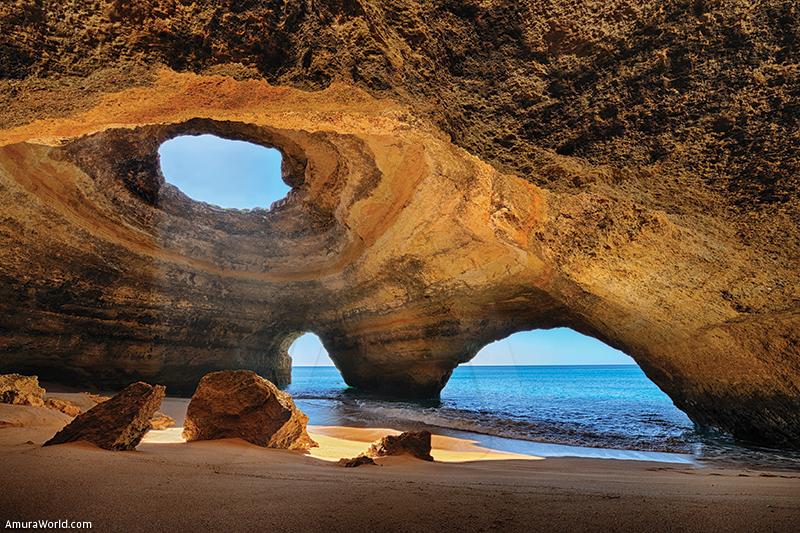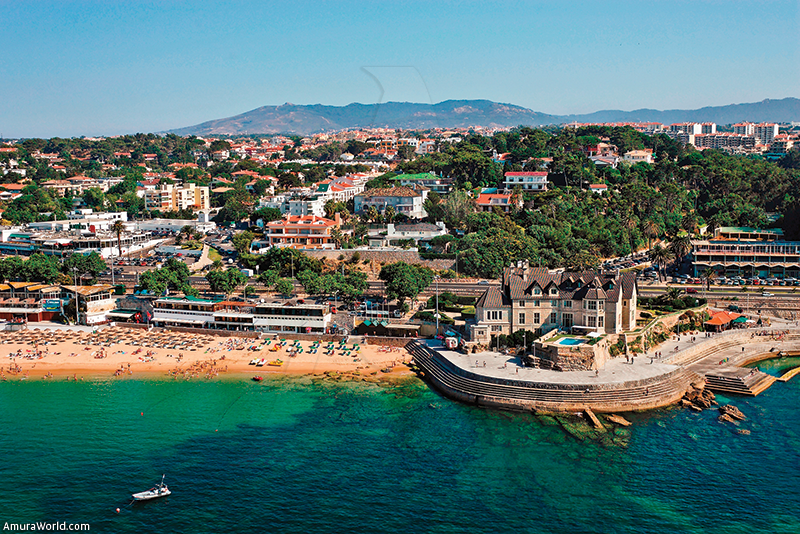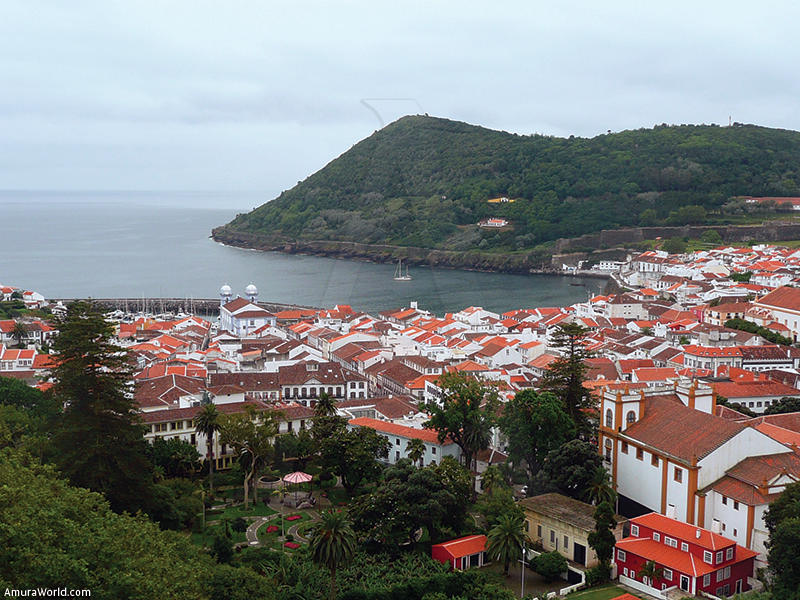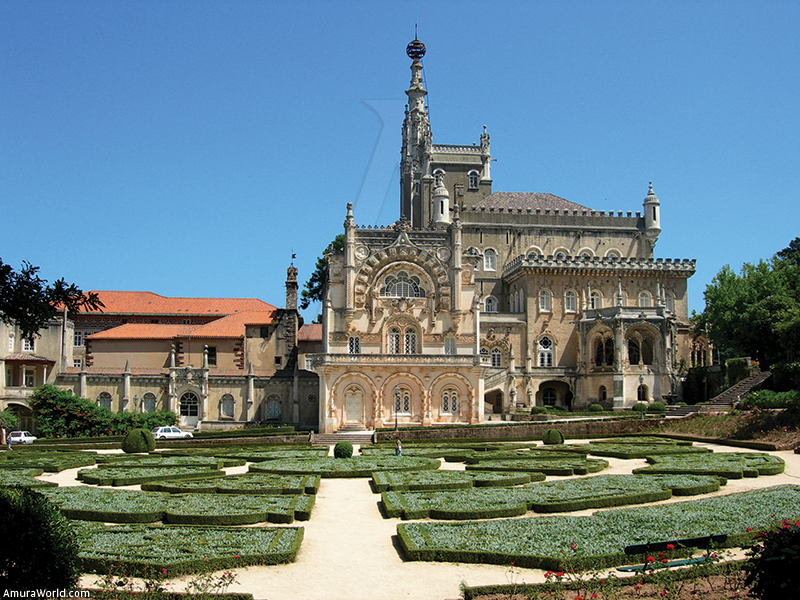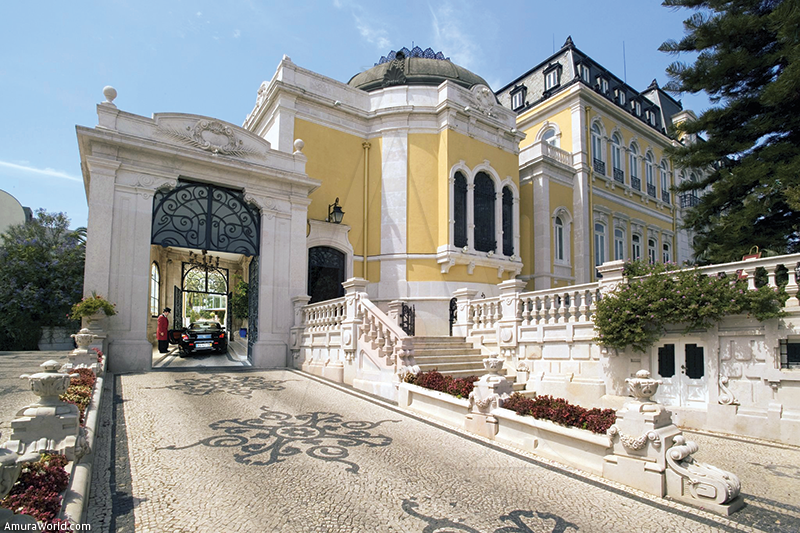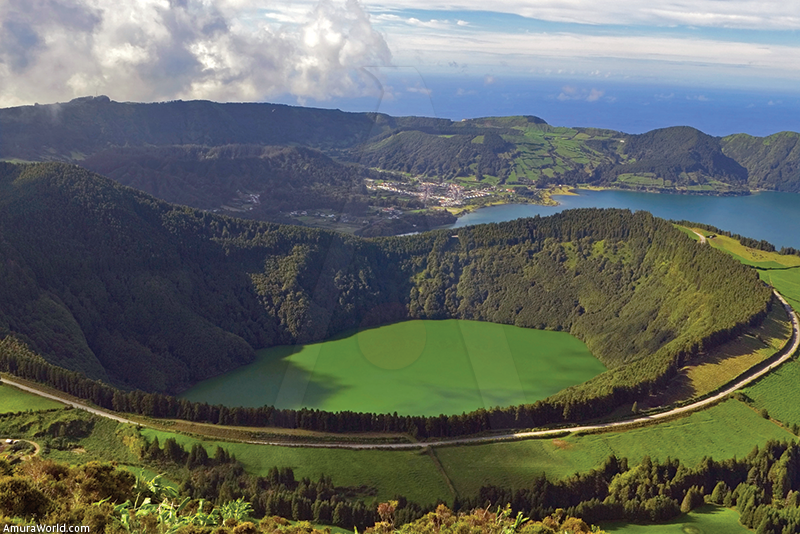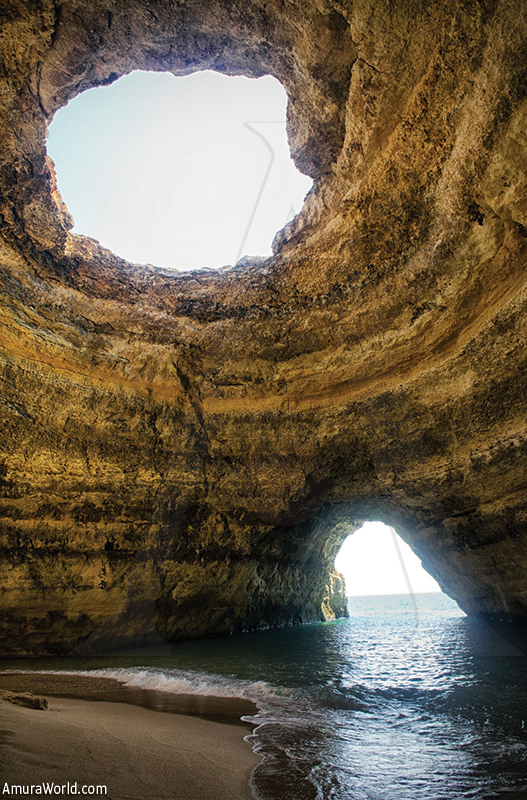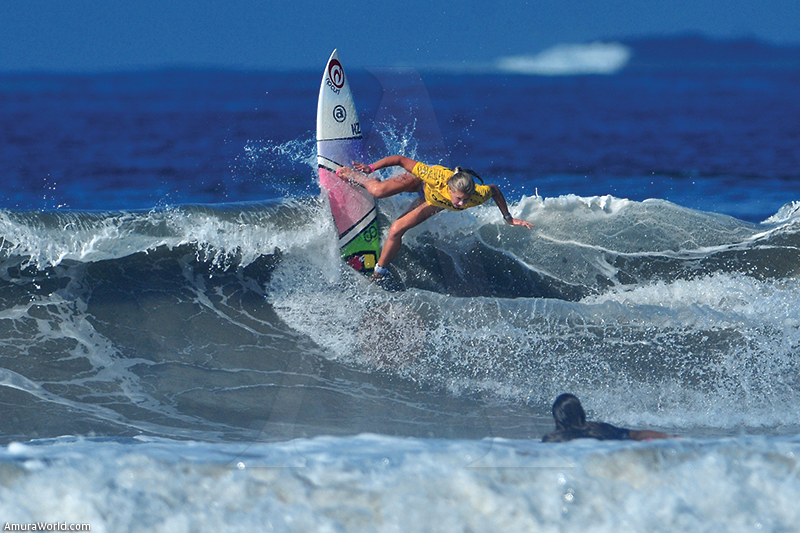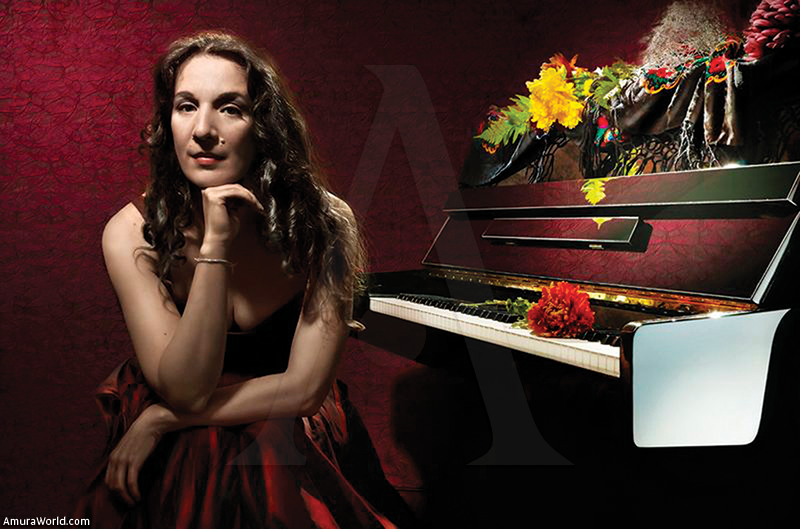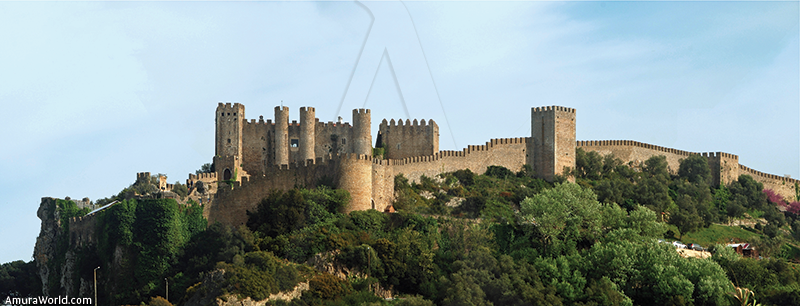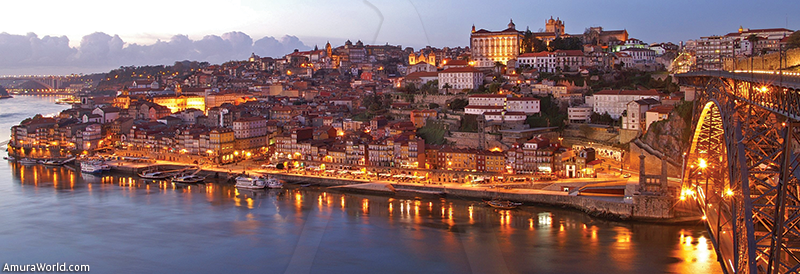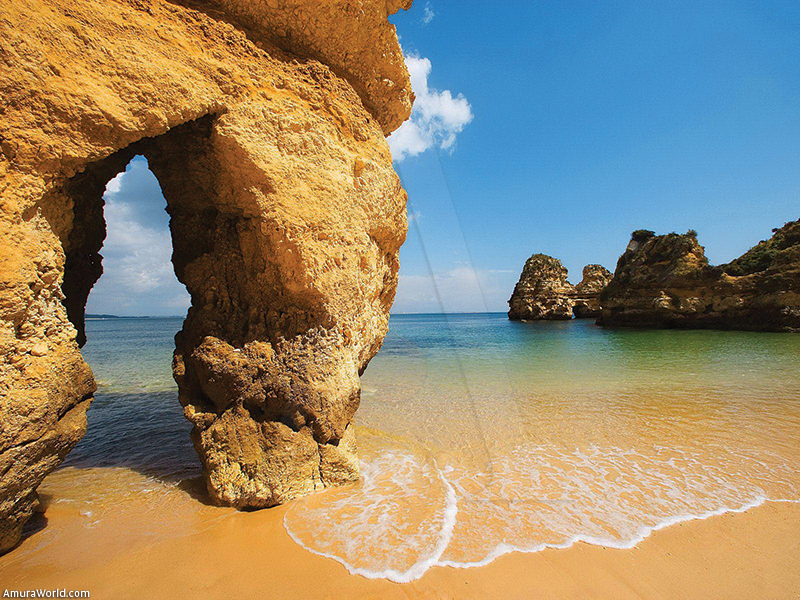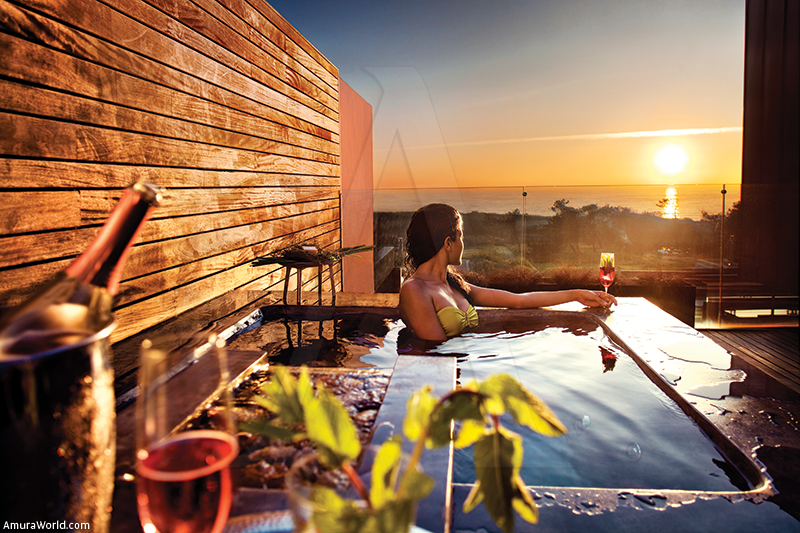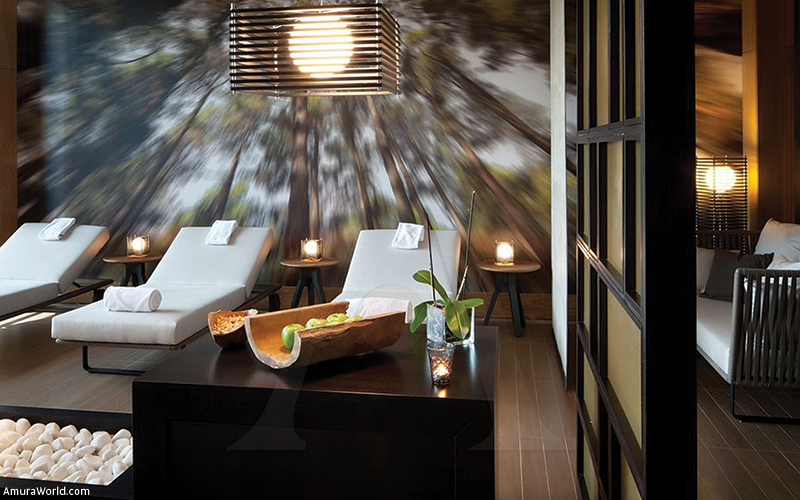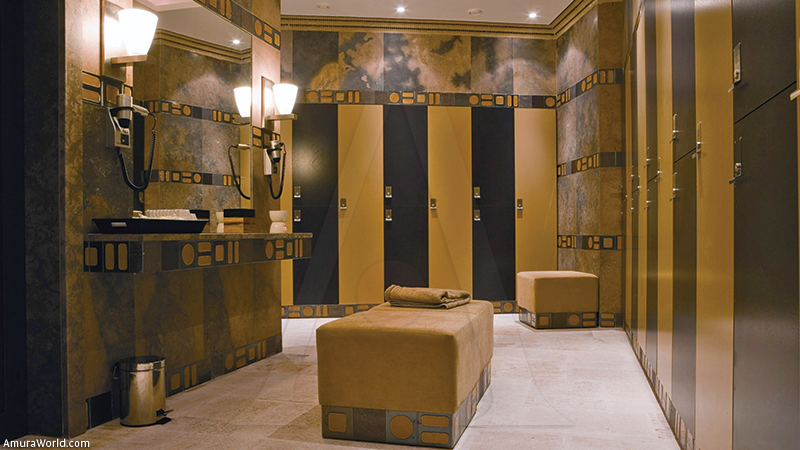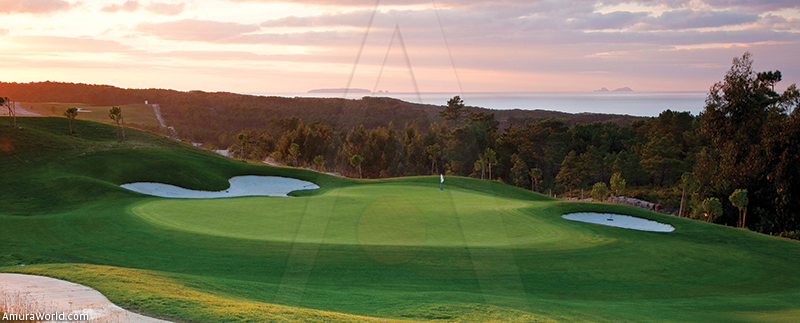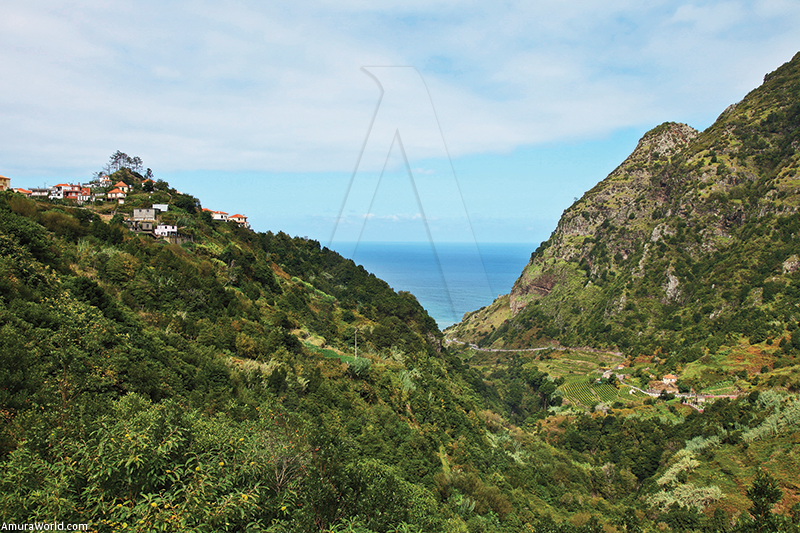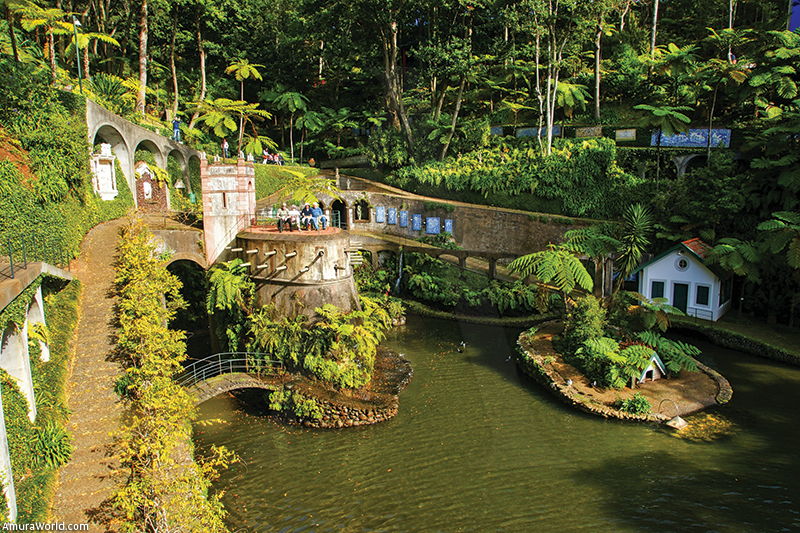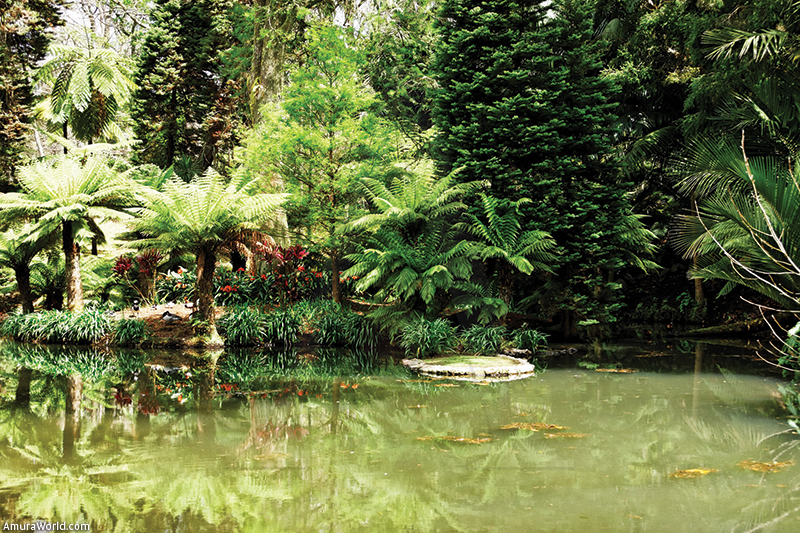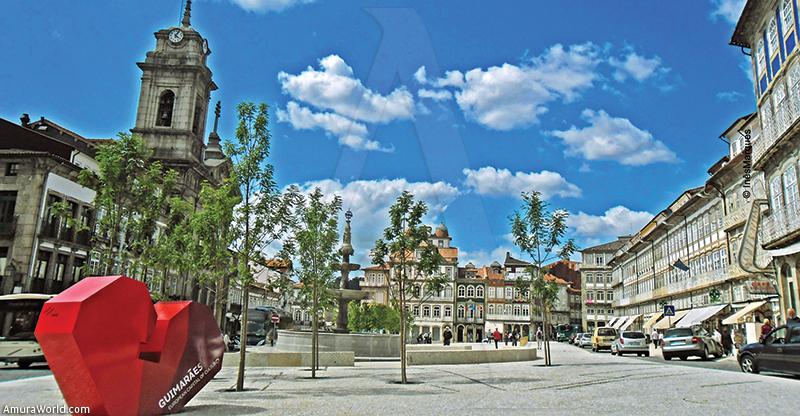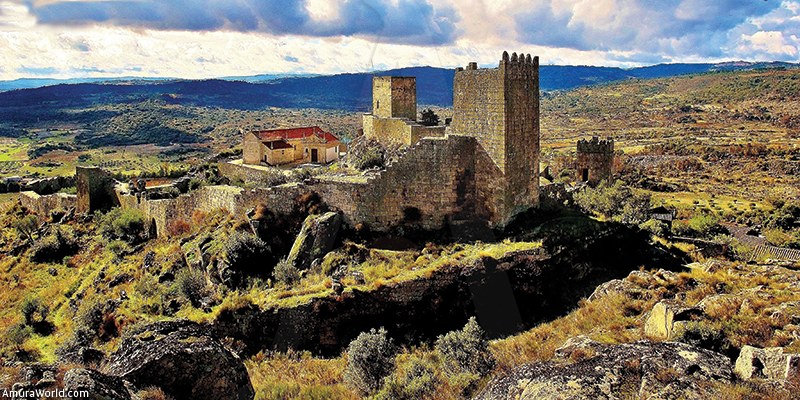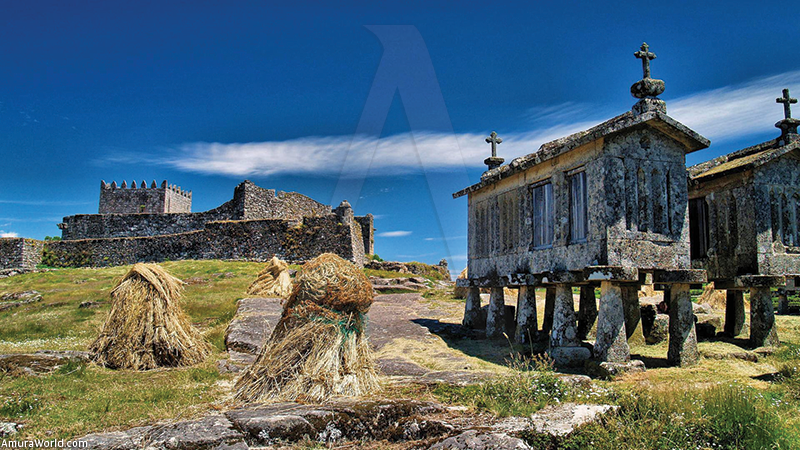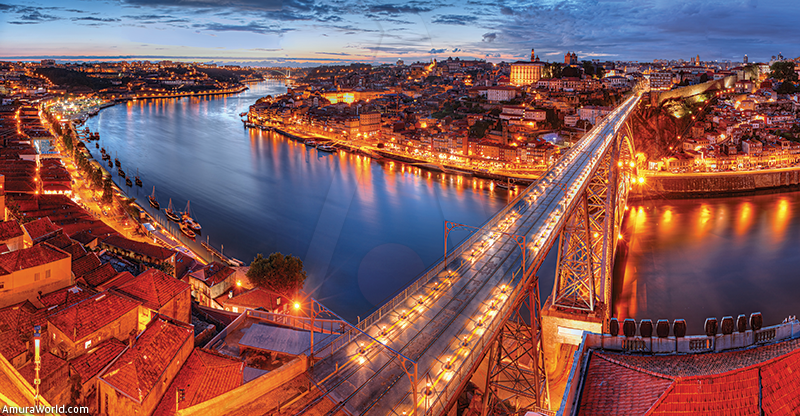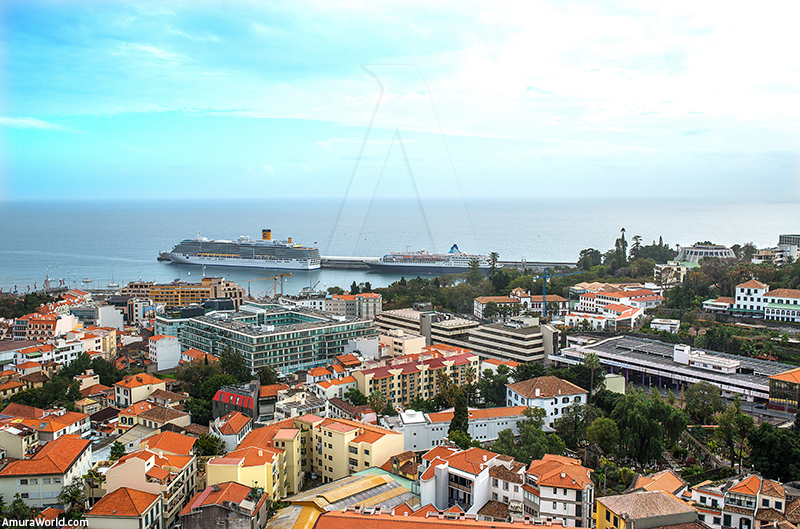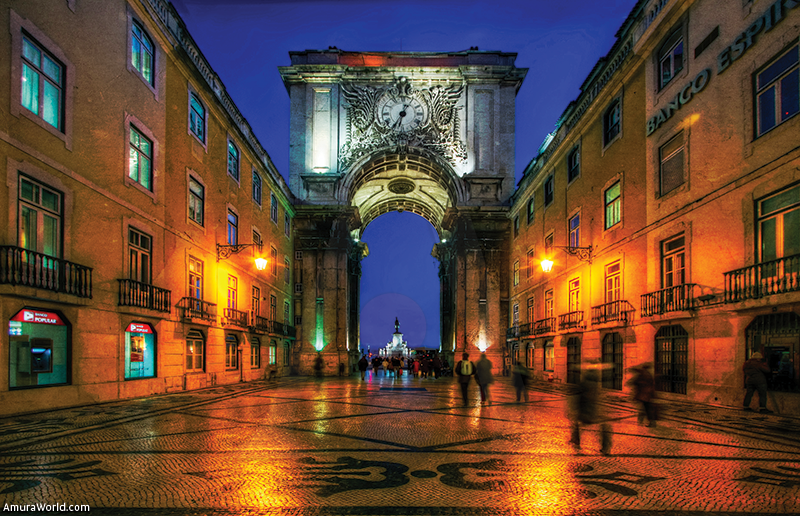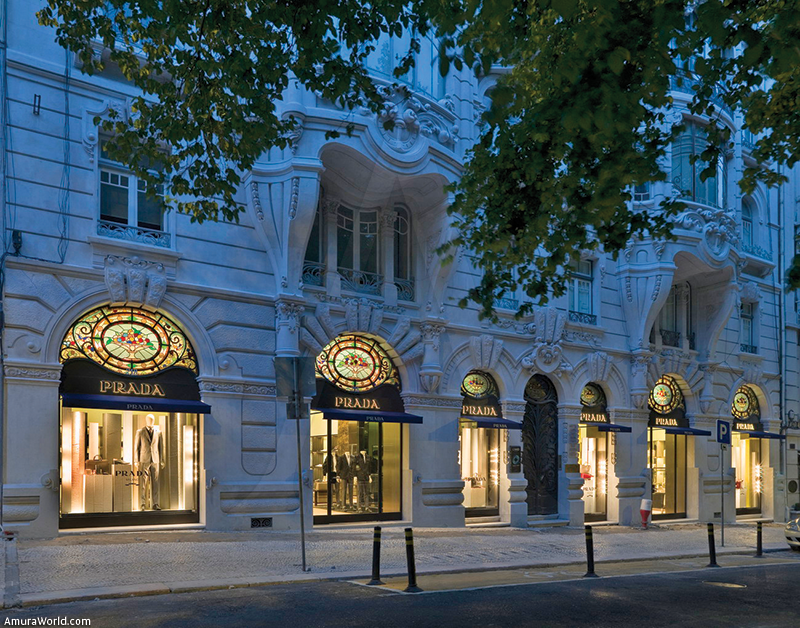Legacy of greats navigators
Though small in size, Portugal is a beautiful country that has known how to conquer and resist, but also wise enough to let go and free itself. Respectful people, valiant and kind, the Portuguese find in the Fado, their typical music, the best way to vent all its nostalgia and melancholy.
History, Tourism and Business
It is a great pleasure for me to collaborate in this issue of Amura, dedicated to Portugal.
Portugal is a country located on the western periphery of Europe and has almost nine centuries of history. Its independence was proclaimed in the year 1143, and since the 14th century it has established borders with Spain, which have remained virtually unchanged.
Portugal is a member of the European Union since 1986, and is using the Euro as its currency. Throughout its history it had a maritime tradition which developed in building an empire in the East in the 15th and 16th centuries, which stretched from Hormuz (Iran) to Goa (India) and Malacca (Malaysia). The Portuguese navigators also reached Macau (south region of China) in the mid-sixteenth century; the Portuguese administration of that territory was maintained until the end of the last century. Other sailors during the same period came to Japan (the port of Nagasaki) and introduced firearms in that country, which came to decisively change the history of Japan.
In Latin America, the Portuguese navigator and explorer Pedro Álvares Cabral discovered in the year 1500 Brazil, on a journey that until today there is the hypothesis of whether the discovery was intentional or casual. The Portuguese presence continues for a short period of time to the colony of Sacramento in Uruguay. In Africa, the Portuguese conquered Ceuta (today, autonomous city of Spain) in the year of 1415, and its presence expanded progressively towards the south and west of that continent until strengthen for the creation of colonies such as Angola, Mozambique, Guinea Bissau, Cape Verde and São Tomé and Príncipe.
These colonies obtained their independence in 1975 after the democratic revolution in Portugal which took place on April 25, 1974. Portuguese colonial empire was the first that was built, and the last to decay with the independence of Democratic Republic of Timor-Leste (Far East) at the end of the 20th century.
The Portuguese language is currently spoken by nearly 250 million people, being this language the fourth most spoken language in the world and the first in the southern hemisphere. Nine countries have Portuguese as their official language: In Latin America, Europe, Africa and Asia, giving to this language a truly universal dimension.
In the tourism sector, subject particularly interesting to the readers of this magazine, Portugal is currently visited by about 12.5 million tourists a year and has a population of 10.5 million inhabitants. Its best-known tourist areas are: Lisbon, Estoril and Cascais, a Portuguese village which is 20 kilometers from the capital, Algarve,-south of the country and has the most famous beaches and the warmest sea of Portugal -Porto, -the capital of the north, which has six bridges, and is the place where the famous wine of Oporto is produced - and Fátima’s sanctuary, which is visited by most Mexican tourists traveling to Portugal and is located approximately an hour by car to the north of Lisbon. The archipelagos of Azores and Madeira are located at 1500 kilometers west of mainland of Portugal and are also another reason for tourist attraction.
Portugal has had considerable success in the modernization of its tourist plans in 25 years. As well as its cuisine which is world famous and well known for the quality of its fish, seafood, wines and sweets, as well as for its beaches. Other tourist areas have been developed in recent years. In the area of rural tourism, there was constructed a range of hotels offering hundreds of hotel-haciendas in the country, which are visited mostly by tourists from northern Europe. In the sector of cultural and historical tourism there was constructed a network of 45 Inns, that were transforming, as a result, to the conversion of castles and historic monuments in small and medium-sized hotels. The city of Fatima was modernized as a religious destination, and a new sanctuary was constructed and is currently visited by over a million tourists a year, mostly in the dates of May 13 and October 13 that correspond to the six apparitions of our Lady of Fatima to the shepherds in the year 1917. Modern sports facilities were built all over the country hosting throughout the year, to national and European athletes, coming mostly from colder countries of Europe. The best Golf Courses of the European continent were built in the south of the country, especially in the last 20 years.
A very special activity for tourism related to water sports: Sailing, a sport traditionally practiced in Portugal, especially in the geographic-axis Lisbon-Cascais. Surfing has been expanded greatly in the last 10 years, mainly in the areas of Ericeira and Peniche, just north of Lisbon, city of major world powers for this sport. It is worth mentioning the fame that has recently acquired the beach of Nazaré, due to its huge waves during the winter months that are already part of the “Guinness Book of Records” as some of the largest waves ever surf.
Portugal has about 2,000 kilometers of continental coastline and about 620 square kilometers of deep continental deep bank, which include rivers and dams. It is for those who come from the American continent the gateway to Europe. In addition, the archipelago of Azores and Madeira have unique conditions for water sports activities and fishing.
In global terms the number of piers and ports in Portugal is approximately of forty, and the total number of places available is about ten or twelve thousand. Most of these places are located in the regions of Algarve and Lisbon, being fifty percent of the total 2700 existing places located in Algarve, and which are occupied by foreign vessels. The condition of the projects of the piers constructed in the last 15 years is considered to be of high quality. The creation of new piers and the modernization of old loading areas and recreational piers, have given over the last few years an important contribution for the requalification of coastal areas, emphasizing the modernizing interventions in Lisbon in the cargo area (in Alcântara) and the Park of Nations (in the Eastern zone).
In cultural terms, the traditional musical expression of Portugal is called Fado and has many followers in the country, with artists such as Teresa Salgueiro, Dulce Pontes and Marisa. This year, big current singers of modern and classic fado as Cátia Guerreiro and Deolinda will be present in October at the Cervantes Festival and will have toured several cities in Mexico. In November, the famous singer Ana Moura will give two shows in this capital.
Modernness of Portugal is little known in Mexico, but the Portuguese investment in this country has increased significantly in recent years. Portugal has a network of roads that corresponds to more than fifty per cent of the network of national roads. Seventy percent of electricity is produced by renewable energy; all public schools in Portugal have internet access and students have computers since there was implemented a public program that was put into practice from 2007, called “E-school” and that resulted in the complete computerization of the school network. In this context, were distributed by the State about 2 million computers. In the area of e-government, all Portuguese citizens have a “cartão cidadão do”, which includes data from six public documents and an e-passport, which prevents review of Customs officers in the European area called “Schengen area”. It is also possible to register a company in an average of 38 minutes by electronic means.
We had recently the privilege of having the presence of the President of Mexico, Enrique Peña Nieto in Portugal, who made a State visit to the country from 5 to 7 June. During this visit, it was possible to define five major business and investment in the areas of infrastructure, environment, renewable energy and tourism.
In the energy sector, stands out the company Martifer Solar, a company which constructed recently in Mexico the largest photovoltaic solar energy park in Latin America, located in the city of La Paz, Baja California Sur (with 132 thousand solar panels). The company EDP Renewables, the third largest wind energy company in the world, will build a wind farm or wind park of 150 MW (megawatts) of capacity in the state of Coahuila, and carry out an investment of about 370 million. The project will be defined in conjunction with the industrial group Peñoles, one of the largest mining groups in the world.
In the area of infrastructure, the company Mota-Engil has been consolidated as one of the five largest companies operating in Mexico. It has a presence in more than ten states in the republic, and its activities include the construction of roads, railways and environment issues (garbage collection).
In terms of education technologies, the E-xample Consortium made up of 26 Portuguese companies is present in Mexico since the year 2011, and their technological solutions (“hardware”, “software” and digital contents) have been acquired by the Ministry of Public Education, (SEP) and they are already present in twelve States of Mexico.
By October 13, a great photo exhibition will be inaugurated on Portugal, composed of 124 photographs that will be presented at the Paseo de la Reforma (Chapultepec). It will be a unique opportunity to learn much more of what Portugal has to offer nowadays, from gastronomy to the beaches and the sea, and modern technologies to the historical monuments, and from traditions of bulls to the marine infrastructure.
Finally, I invite the readers of the Amura magazine to consult the Internet page ““Elija Portugal / Facebook” , where you can find recent information about the current Portuguese condition and community activities and businesses in Mexico.
Way of life
Portugal is the sunny country of Europe, as it receives over 250 days of Sun a year, which is highly appealing if you pair this with the huge amount of beaches that satisfy the expectations of anybody who vacations in it.
Sharing the Iberian Peninsula with Spain, Portugal is a few hours away from any of the European capital cities. It has communication by air, sea and land, and it offers a tranquil and open ambience, which makes of Portugal a focal point to all visitors that come from all over the world.
Portugal owns the oldest frontiers in Europe and it has an ample diversity of landscapes that cover all possible options, like mountains, valleys, woods, volcanoes, lakes, all kind of beaches, modern cities, enchanting towns full of traditions and all are close to each other. In this country of kind and intense people you will find such variety of options to enjoy yourself and a cultural heritage resulting of all the centuries of adventure that the Portuguese people lived. Tradition and modernity join in harmony, creating the perfect balance. A rich gastronomy that takes advantage of the natural resources of the country’s fauna and flora, the excellent and unique wines, like the Port and green wine, added to the charm and hospitality of its people, completes the touristic offer that you will find when you come to visit.
For over 3,000 years, Portugal has witnessed the coming and going of various peoples. Its culture carries the trace of Phoenician, Greek, Celt, Carthaginian, Roman and Arab civilizations.
In the 15th century, the adventurous exploring sailors led by Vasco da Gama, discovered new land and began the creation of the Portuguese overseas Empire.
Also, this land owns a rich history of sailing and discoveries. Looking towards the Atlantic Ocean from the Iberia Peninsula, Portugal’s history has left an indelible trace in Culture, which is noted in the Arab and Oriental influences in both architecture and arts.
A country that promotes culture and knowledge, and have one of the oldest universities in Europe: the University of Coimbra, founded in 1290, and located in the city from which it takes its name. A students city, very cultural, historic and with an antique essence.
It is important to point that Portugal is basically a country to be known by car.With over 2000 km of great highways, the best way is to use this kind of transport. From North to South, Portugal has 750 km, which means you can reach the other end of the country in 6 hours. However, with so much to see, enjoy and discover, it will take you longer than the estimated time.
These visitors pick one of the two main seasons that Portugal offers, the Summer season (July-August), with typically familiar activities, due to the school vacations, and they cover beaches and outdoor activities and sports, or they chose the Spring-Fall season (May-June, and September), for people -mostly adults- who seek more comfortable activities with nicer weather, like the Vendimia in the Duero river during September.
Sun & beaches
The Atlantic Ocean bathes its 850 km of long coast, accompanied by a brilliant Sun, delighting skins and warming souls. Alongside comes the white fine sand of its beaches, being large sandy areas or small coves surrounded by rocks, where each one has its own amazing beauty.
Some are crowded and lively, others are deserted and unexplored, like secretes to be discovered. But there is always one for every taste and mood. You can have some to relax lying on the sand, to stroll by the seaside, to fall in love, or to play and have fun all night long. In spite of its many differences, all have something in common: their quality. That is obvious in the number of European blue flags that they receive each year, and that certify the excellents conditions and infraestructures of their more of 300 beaches, due to its level of cleanliness and environmental friendliness. The sea, of limpid waters, gifts us with different temperaments. Quiet and tranquil for resting or agitated and with the perfect waves for practicing various aquatic sports that guarantee lots of adrenalin. With a sea temperature of 17° to 18°C, to take a dive in the sea is quite appealing to those visiting.
Art & Culture
Hundreds of centuries back, Portugal was already with inhabitants, even though its frontiers -as we know them today- were defined merely 8 centuries ago. This long history reflects on a unique culture that resulted of the union of different peoples that lived here and those that the Portuguese encountered along the discoveries through their travels.
This rich culture is found in villages and cities, in their monuments and traditions and is continuously changing when the Portuguese creatively absorb the influences of other parts of the world. The sea, always present, also molded the Lusitanian personality and took it beyond the European continent, allowing the brave and valiant Portuguese to learn from the rest of the world and to share with it what they bring to the table.
In reality, Portugal is a splendid country, filled with singularities, such as the Manuelino art, the tiles and the fado, that are not only unique expressions and authentic symbols of the Portuguese, but a part of their contribution to the world heritage. Portugal has contributed with 16 monuments, sights and other treasures to the list of the UNESCO.
While picking a region or an itinerary or a specific theme, you can discover different sights and heritage that maintain the authenticity of the local traditions. It can be said that the Lusitanian Culture is a living thing that renews itself constantly.
Religious Tourism
A Route of temples, cults, and religious festivities that we can follow moved by faith, by a more universal spirituality, or by the pleasure of admiring the creative work of the human species that has left such incredible samples in this territory. Starting with Fatima, capital of the peace and one of the most visited Marian pilgrimage in the world. Where on May 13th hundreds of thousands of pilgrims arrive to celebrate the day in which Our Lady of Fatima showed herself for the first time to the children shepherds on 1917. On the night of May 12th, the Candle Procession takes place which is worth living. From May to October ceremonies are carried out each 13th, for it was always on this day that Our Lady of Fatima appeared for the six times.
Escapades
While in Port, the cities of Braga and Guimarães -this last one is part of the World Heritage-, the National Park of Gerês, the Geopark of Arouca or the Duero River are options to take into consideration. From Lisbon you can very quickly arrive to the World Heritage of Sintra, to the Estoril Coast or to the Natural Parks of the estuaries of Tajo and Sado Rivers. By the Sado you can find the Arrabida Natural Park and Palmela, Sesimbra and Setubal that offer beautiful sights of the sea. A little bit more to the South but merely an hour by car, you can find Evora, which is also a World Heritage. As Evora, the Monasteries of Alcobaça and Batalha, North of Lisbon, right after the medieval fortified Villa of Obidos.
Weather & Surfing
If you are a surfing lover, Portugal is a must. Here you can practice surfing all year round, the large Portuguese coast has good waves every day, and since there are many ways to ride a wave, it all depends on the talent and the level of adventure of each one. From November to February, in the beach of Nazare -as the ambassador has mentioned- you will be able to watch a phenomenon quite rare in other parts of the globe: the gigantic waves, of up to 30 m, like the one that MacNamara, the Hawaiian surfing expert, rode last year. The variety of natural conditions and the exceptional weather, offer unforgettable experiences for everyone, to the one who is beginning, all the way to the most experienced.
Nautical Tourism
The large Portuguese coast is a Paradise to those who love the recreational sailing, who here they find a sea to their liking.
Some areas are considered amongst the best regatta fields of the world, and that is why international events and championships are carried out there. In the deeps of the sea, those who enjoy snorkeling and diving may discover a wealth of biodiversity, with fish of all colors and maybe a sunken historical treasure.
The history of Portugal is packed with great deeds of brave sailors who crossed unknown seas and bent capes, surviving extreme storms in order to reach the other side of the world. Today, sailing is full of state of the art technologies, and the Portuguese still love the sea, the adventures, and being hospitable to those who visit their country. Those who arrive by boat find –throughout the whole country- sporting and recreational ports with excellent infrastructures and services, where they can safely dock and then discover the marvelous places offered inland. The offer of high quality Marinas in the country is ample, being possible to dock close to historical, natural or sport attractions.
Health & Well-being
There are several health and well-being programs that cover the expectations of most people. This relaxation moments may be enjoyed in baths, with traditional techniques; or enjoy the long coast and the waters of the ocean to practice thalassotherapy; or perhaps with sessions based on the regenerative effects of wine, chocolate or heated stones, that can be found in the five-star hotels and the spas, offering a cellular regeneration session and the acquisition of balance through meditation and relax.
Golf
Portugal has almost 80 golf fields in the country in surprising scenarios, with greens that face the sea, or are surrounded by cliffs or white sand dunes or framed by lakes and mountains, where the flower scents mix offering lovely fragrances to the senses; it is almost impossible to avoid distractions that break the concentration required by the game. The Portuguese golf fields are considered the best in Europe, especially those in Algarve.
Some of these greens were designed by famous architects such as Henry Cotton, Rocky Roquemore or Arnold Palmer; and have in common the subtle integration with the nature that surrounds them. The Azores offer a rustic golf that is practiced in a rural environment. The practice of Golf has its origins in Port and North region and it is in Espinho where you can find the second oldest green in continental Europe and the oldest of the Iberian Peninsula, and was founded in 1890.
Places to visit
This amazing place offers an interesting variety of options: kitesurfing in the beaches that allow it, bicycle rides in mounts and valleys, rappelling and ascents, and the zip-line for the most adventurous. You will find big challenges in the waves, tubular, gigantic or long, perfect for surfing. You can practice windsurf, sailing and paragliding that will rise your emotion to unbelievable heights. Portugal offers you the opportunity to practice rafting, canyoning and kayaking in its rivers, or to search for the spring in the depths of the earth while practicing speleology. If you enjoy less adrenalin, Portugal offers you promenades on foot or rides on horseback, as well as mountaineering to watch the birds in their environment. You can also go on a boat to watch dolphins, cachalots and whales.
Porto
Porto is the entry and the starting point of a trip to the natural and cultural diversity of the Region. It is known for the Port wine that is sent from here to the rest of the world. This Natural Parks and mountainous zone, is sprinkled by castles, like the Guimarães, or sanctuaries and churches that in summertime are scenarios for Romerias. In cities like Viana do Castelo, Braga, Lamego, Chaves or Vila Real, you will find the most authentic Portuguese, the one who enjoys sharing his table, his costumes and traditions. In Braga, by the Minho River, the famous green wine (vinho verde) is produced, which is unique to the world. Porto is traditional and cultural; it was Europe Capital of the Culture in 2001. And it gives an interesting route that runs alongside the river visiting the wine producing farms, a tasting adventure for wine lovers.
If you have just few days to visit Port, there are places you cannot miss. This city has something mythical that can hardly be described and varies depending on the place, the hour and the light of the day. Surely, it has to do with people, known by their kind and generous character and also with the Duero River, where you can find the wineries of Port wine -on the Gaia side- that are catalogued as world heritage.
São Bento Station, with its foyer covered in tiles, is the ideal place to initiate your trip. A little further down the road do not miss the Cathedral. From there you can go down the stairs and medieval streets to the Ribeira, with its terraces and picturesque corners. Then you can take a cruise under the six bridges of Port. Then, you can visit the golden interior of the San Francisco Church. Parting from the River, the trolley makes a route that leads to Foz. Not very far away you will find Serralves, with gardens to stroll in or rest, and Contemporary Art expositions.
In this city you will find restaurants of all kind that offer dinner, from the traditional cuisine to the modern fusion cuisine from famous chefs. One of Port’s specialties is the famous francesinha, a sandwich with various fillings, covered in sauce that is not easily found elsewhere in the country. But you can also find the popular fresh fish and seafood platters, that are highly recommended, as well as the cod or meat platters, amongst which the “guts Port style” and the kid are outstanding. As starter you can always ask for green broth, typical of the region.
Portugal cruises
Here boats from all over the world arrive, be by the Atlantic Ocean, by the west side, or by the Mediterranean Sea route, to the South or by the Madeira and Azores archipelagos. Whoever arrives by cruise finds in the cities of Port, Lisbon and Portimão a good number of points of interest that deserve to be explored. Ponta Delgada, in the São Miguel Island of the Azores archipelago, or the city of Funchal, in the Island of Madeira, also receives the visitors that arrive by sea with all the commodities and sympathy.
Lisbon
A cosmopolitan city in essence, Lisbon is known as the White City, name that emerges from the peculiar characteristic of the light that the sun produces while reflecting on the waters of the river that runs through the city and ends up mixing with the sea, effect that expands over the city where the Tejo river flows.
To walk through the grid of streets of Baixa that opens to the Tajo in Praça do Comercio, and then meet some of the prettiest places of the city: the incredible zone of Belem with monuments considered World Heritage, medieval quarters and relaxation zones, like the Nations Park.
Lisbon is a city that calls to be discovered slowly, enjoying what you discover in each district, in each street. It is a safe and fun city, with lots of things to see, but relatively small. It is ideal to spend several days or like a starting point to visit the country. It is antique, it is modern and it is always surprising.
The offer is ample: Roman, Manuelin, Baroque, Romantic, Literary, Bohemian, Nocturnal Lisbon or as the city of fado. There are also lots of ways to visit it: on foot, by trolley, Segway, hop-on-hop-off bus, tuk-tuk, from the river by boat or from the other side of the river, after crossing the Tajo in a cacilheiro boat. The suggestions are infinite. However, there are some places you cannot miss and are always part of the list. Like the historical district of Alfama and Castelo, with one of the best views of the city and the river.
You have to pass by Baixa on your way to Belem, the discovery district, with the Tower of Belem and the Monastery of the Geronimos, with the original Car Museum or the Cultural Center of Belem. And you simply cannot skip trying one of the delicious pasteis da natas, a specialty of Belem.
In the new part of the city, you can visit some of the reference museums, such as the Calouste Gulbenkian Museum, in the North zone, and, following the river, the National Museum of Tiles. On your way to the Park of the Nations, you will find the totally rebuilt port zone because of the Universal Exposition of 1998. Today, it is an important recreational space with a new urban landscape. Lisbon is an unforgettable city!
Shopping in Lisbon
In the Cosmopolitan city of Lisbon, everything is within a short walk. For the people of Lisbon, Baixa has always been the place for shopping. The Avenida da Liberdade is one of the main streets of the city, with century old trees and fresh shadows. It is very pleasant to stroll there. You will find here the signature hotels as well as the five-star ones, famous brands, luxury stores, restaurants and terraces.
In Baixa, the most traditional stores are side by side with the more avant guard ones that offer the most recent creations and tendencies. Always charming result the century old Casa das Velas do Loreto, Chapelaria Azevedo or Luvaria Ulisses. Just like the antique bookstores Bertrand, Sa da Costa y Aillaud & Lellos, where you will lose the sense of time passing while you leaf through the most recent literary novelties. Just like that you will enjoy the Notion Stores on Rua da Conceição that still have the original furniture in which an incredible amount of buttons and threads are kept.
Between Chiado and Bairro Alto, between the ruins of the Carmen Convent, of the Chiado Museum, and the San Roque Church, you can also find the designer’s most recent creations.
Bairro Alto is still considered the most bohemian district of the city. During the day it has stores that offer urban fashion, avant guard and tattoos.
Close by, you will find the Royal Prince, a residential zone with gardens, terraces, decor and Portuguese designer shops. You will also find the Rua de São Bento, where Antique stores offer their goods. In addition, you can find the Republic Assembly and the House Museum of Amalia Rodrigues.
The Santos district is an old industrial zone by the river that has been dedicated to the design. It has attracted art schools, artist studios, architecture firms and creative agencies. This is the site chosen by contemporary design brands of furniture and decoration to set their commercial spaces. You can also find the National Museum of Antique Art, one of the most important of Lisbon.
If you have no time to shop while strolling through the Historic Districts of the City, you can do so in one of the malls: Amoreiras, Colombo and Vasco da Gama are the largest, but Campo Pequenho and Saldanha are an alternative to take into consideration.
Cais do Sodre
To follow the night and dance, Cais do Sodre is one of the most popular zones today. This zone that have bars with names of northern Europe capital cities and of faraway countries is now one of the quietest of the Lisbon night, with cultural spaces, restaurants, bars, clubs and discos.
Terreiro do Paço
The door to Lisbon by the river, emblematic for its history, symbolism, and dimensions is the Praça do Comercio or Terreiro do Paço that was, until recently, the house of the Executive Power, where various Ministries of the Portuguese Government were situated.
Santa Apolonia & Jardim do Tabaco
When coming down the Alfama hill you will find Santa Apolonia and Jardim do Tabaco. Those names have always been associated to the train station and the cargo port, to where cruises arrive today which enjoys a new life lately. Reference restaurants and one of the most popular discos are now where the old warehouses that served the port were.
Parque das Nações
The ample Coast, in the eastern part of the city, suffered a total transformation to house the Universal Exposition of 1998, which gave birth to a district of modern architecture and lots of commercial and recreational spaces. With drives by the river where you can find restaurants and terraces to start the night, amongst other attractions, you will find the Camões Theater, house of the National Dance Company, the Atlantic Pavilion where lots of concerts happen and the Casino of Lisbon, that on top of the gaming halls, it has multicultural spaces with music and expositions.
Portugal & Mexico
150 years of Diplomatic Relations between Portugal and Mexico. For the first time since this space was opened to the public, the railings of Chapultepec Park will carry a photographic sample set by a foreign country. To celebrate the 150 years of Diplomatic Relations between Portugal and Mexico, it will open a sample of 114 photographs of Portugal, on October 13th, 2014.O
Text: João Caetano da Silva Embajador de Portugal en México ± Photo: © Getty Images / LISBON SECRETS / bp / WPD / EOS / CLOUDFRONT / ZOOM port ca / ENTRE MAGAZINE / ORBITUR / SYNTORAMA / AMDALU / ABOT

